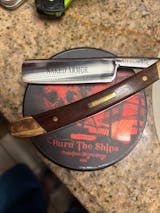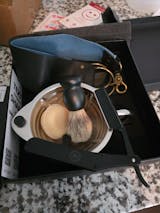The Best Straight Razor For Beginners

Straight razors can be a great choice for those who want a close and precise shave, but they require some skill and practice to use properly. The best straight razor for beginners depends on your preferences and needs. It is a good idea to try out a few different razors before deciding which one feels the most comfortable and easy to use.
Here, we’ll let you in on everything you need to know to start your wet shaving journey:
- Parts Of A Straight Razor
- The Best Steel For Straight Razor
- Different Types Of Straight Razors
- How To Hold Straight Razor
- How To Clean Straight Razor
- Straight Razor Vs. Modern Razor
When choosing a straight razor for beginners, there are a few key factors you first need to consider:
- Blade material: Straight razors are typically made with high-quality steel, such as carbon or stainless steel. Carbon steel blades are generally sharper and easier to maintain but may rust if not cared for properly. Stainless steel blades are more resistant to rust and are a good choice for those less experienced with maintaining a straight razor.
- Blade size: Beginners may want to choose a smaller blade size, such as a 4/8 or 5/8 inch blade, as these are easier to control and less aggressive. As you become more experienced with straight razors, you can experiment with larger blade sizes.
- Blade grind: The blade grind refers to the shape of the blade. A full hollow grind blade is thinner and sharper but may be more difficult for beginners. A half-hollow or quarter-hollow grind is a good compromise between sharpness and ease of use.
- Handle material: Straight razors can have handles made of various materials, including wood, bone, or synthetic. Wood handles are traditional and have a classic look, while bone handles are more expensive and have a more luxurious feel. Synthetic handles are durable and easy to maintain and may be a good choice for beginners.
There is no single "best" straight razor for beginners because everyone has different wants and needs. It is a good idea to experiment with various razors to find the best one. Learn more about the parts of a straight razor.
Parts Of Straight Razor
A straight razor is a type of razor with a blade that can fold into the handle. It consists of several parts:
- Blade: This is the sharpened edge of the razor used to cut hair. A straight razor blade is typically made of high-carbon steel and can be honed to a very sharp edge.
- Point: The point is the end of the blade used for precision work, such as shaping the edges of a beard or mustache.
- Spine: The spine is the back of the blade, opposite the cutting edge. It helps to provide stability to the blade and also helps to balance the weight of the razor.
- Scale: The scale is the handle of the straight razor. It can be made of various materials, including wood, plastic, or bone.
- Pivot: The pivot is a hinge that allows the blade to fold into the handle. It is typically located at the center of the scale and helps to keep the blade securely in place when the razor is not in use.
- Tang: The tang is the blade part that extends into the scale. It helps to hold the blade in place and also provides some leverage when it is opened or closed.
The Best Steel For Straight Razor
The best steel for a straight razor depends on several factors, including the intended use of the razor, the level of sharpness and edge retention required, and the level of maintenance the user is willing to perform.
-
Carbon steel is popular for straight razors because it is relatively easy to sharpen and can hold a sharp edge. However, it is more prone to rust and corrosion than other types of steel, so it requires regular maintenance to keep it in good condition.
-
Stainless steel is another common choice for straight razors because it is more resistant to rust and corrosion than carbon steel. However, it is generally more difficult to sharpen and does not hold an edge, as well as carbon steel.
- High-carbon stainless steel is a blend of carbon steel and stainless steel that combines the advantages of both types of steel.5 It is relatively easy to sharpen and holds a sharp edge well, but it is also resistant to rust and corrosion.
Other factors to consider when choosing the best steel for a straight razor include the blade's thickness, blade grind, and handle material. It is generally recommended to choose a straight razor with a blade made of high-quality steel and a handle made of durable, comfortable material.
Different Types Of Straight Razors
Several types of straight razors are distinguished by their blade point, sizes, grind, and other features. Hence, it is why straight razor types come in according to their blade points and grinds.
Straight Razor Points
The point of a straight razor is the tip of the blade. It is the most delicate and precise part of the blade and is used for fine work, such as shaping eyebrows or removing ingrown hairs. The shape of the point can significantly impact the performance and versatility of the straight razor.
In general, choosing a straight razor with a point that is appropriate for your level of experience and the type of shave you prefer is recommended. Round points and Spanish points are good choices for beginners or people with sensitive skin, while square points and French points are better for more experienced users or people with thicker or coarser hair.
- French Point: A French point straight razor has a pointed tip designed for precise, detailed work. It is a good choice for shaping eyebrows or removing ingrown hairs.
- Round Point: A round point straight razor has a rounded tip that is less sharp than a French point. It is a good choice for general shaving, as it is less likely to cause accidental cuts.
- Spanish Point: A Spanish point straight razor has a curved, elongated tip similar to a French point but with a more pronounced curve. It is a good choice for shaping and detailing.
- Square Point: A square point straight razor has a squared-off tip that is good for general shaving and is less likely to cause accidental cuts.
There are also custom straight razors made to the specific specifications of the user. They can be made with any blade shape, scale material, and other features. We recommend that if you are starting out that you select a round point straight razor like the Solomon Straight Razor.
Straight Razor Grinds
The grind of a straight razor refers to the blade shape as it tapers from the spine to the edge. The grind of a straight razor can significantly impact its performance, including its sharpness, durability, and ease of use.
- Full Hollow: A full hollow straight razor has a blade that is ground to a very thin edge and is concave on both sides. It is a good choice for experienced shavers who want a very close and comfortable shave.
- Half Hollow: A half-hollow straight razor has a blade that is ground to a medium thickness and is concave on one side. It is a good choice for those who want a close shave but do not have the skill or experience to use a full hollow straight razor.
- Quarter Hollow: A quarter hollow straight razor has a blade that is ground to a thicker edge and is concave on one side. It is a good choice for those new to straight razors and want a blade that is easier to use and maintain.
- Wedge: A wedge straight razor has a blade that is ground to a very thick edge and is wedge-shaped. It is a good choice for those who want a blade that is easy to use and maintain but still provides a close and comfortable shave.
Shavette Straight Razor
Have you heard of the straight razor shavette? A shavette is a type of straight razor that uses disposable blades instead of a traditional blade that can be honed and sharpened. The blade is held in place by a clamp and can be easily replaced when it becomes dull. This is what most barbers use in the professional setting and they are great for beard lines and sculpting facial hair.
Back to traditional straight razors . . .
Blade size, point, and grind should all be just right for a straight razor to be considered among the best of its kind. Crucially, the blade must be crafted from high-quality stainless steel, carbon steel, or even Damascus steel.
The best straight razor for beginners is a 6/8" straight razor blade with a Dutch or round point and a half or full hollow grind. It provides an easier learning curve and makes the best straight razor for sensitive skin as it offers a gentler shave. The thicker blade and the extra defense provided by the rounded point make for a kinder, gentler, and safer shaving experience by reducing the likelihood of cuts and nicks.
How To Hold Straight Razor
Holding a straight razor correctly is important for achieving a smooth, comfortable shave and minimizing the risk of cuts or nicks. Here are some tips for holding a straight razor:
- Grip the handle firmly but not too tightly. The handle should be held in a comfortable, natural position, with your fingers wrapped around it and your thumb resting on the blade stop.
- Keep your wrist relaxed and flexible. A rigid wrist can make it more difficult to control the blade and may increase the risk of cuts or nicks.
- Hold the blade at a slight angle to your skin. The blade should be tilted slightly away from your face, with the edge facing downward. This helps minimize the cut risk and maximizes the blade's cutting efficiency.
- Use a light, steady touch. Don't apply too much pressure to the blade, as this can cause the blade to drag or skip across your skin and increase the risk of cuts. Instead, use a light, steady touch and let the weight of the blade do the work.
- Keep the blade parallel to your skin. As you shave, keep the blade parallel to your skin rather than tilting it at an angle. This helps to ensure an even, consistent shave and minimizes the risk of cuts or nicks.
It is important to remember to use caution and take your time when using a straight razor. Start by practicing on small areas of your face or neck, and gradually work your way up to larger areas as you become more comfortable with the blade.
How To Clean Straight Razor
Cleaning a straight razor is important in maintaining the blade and ensuring it stays sharp. Here are the steps to clean a straight razor:
- Rinse the blade with warm water to remove any excess soap or hair.
- Soak the blade (not the handle) in a mixture of warm water and a small amount of mild soap for about 15 minutes. This will help to loosen any dirt or debris that may be stuck on the blade.
- Use a soft-bristled toothbrush to gently scrub the blade, paying special attention to the edges and crevices. Be sure to brush in the direction of the blade to avoid damaging the edge.
- Rinse the blade thoroughly with warm water to remove any soap or debris.
- Dry the blade thoroughly with a clean, dry cloth. Be sure to dry the blade completely to prevent rust from forming.
- Apply a thin layer of blade oil or the Naked Armor natural balm to the blade to protect it from rust and wear.
- Store the blade in a dry place, such as a protective case or a blade bank, to prevent it from getting damaged or dull.
Remember to handle the blade carefully during cleaning to avoid accidentally wounding yourself.
Straight Razor Vs. Modern Razor
 Straight razors have a single-edge blade while modern razors often have two or more blades.
Straight razors have a single-edge blade while modern razors often have two or more blades.
A straight razor, also known as a cutthroat razor, is a type of manual razor that consists of a single, thin blade that can be folded into a handle. Shaving with straight razors is considered the traditional shaving method and has been in use for centuries.
On the other hand, modern razors are typically equipped with multiple blades and use disposable cartridges that can be easily replaced. They are designed for convenience and ease of use and are widely available in various shapes and sizes.
There are several key differences between straight razors and modern razors:
- Blades: Straight razors have a single, long blade that must be honed and sharpened regularly to maintain its edge. Modern razors have multiple blades set at different angles and can be easily replaced when they become dull.
- Shaving technique: Shaving with a straight razor requires a specific technique and can take some time to master. Modern razors are generally easier to use and do not require as much skill or precision.
- Maintenance: Straight razors require more maintenance than modern razors. The blade must be honed and sharpened regularly, and the razor must be cleaned and oiled to prevent rust and wear. On the other hand, modern razors require minimal maintenance and can be easily replaced when they become dull.
- Cost: Straight razors are generally more expensive than modern razors, particularly when you factor in the price of maintaining the blade. Modern razors are typically less costly, especially if you opt for a subscription service that delivers new cartridges regularly.
Ultimately, choosing between a straight and modern razor will depend on your personal preferences and needs. Some people prefer the tradition and ritual of shaving with a straight razor, while others prefer a modern razor's convenience and ease of use.
Benefits Of Straight Razor Shaving
There are several benefits to using a straight razor for shaving, including:
- Closer shave: Because straight razors have a single, long blade that can be honed to a very sharp edge, they can provide a closer and more precise shave than modern razors with multiple blades.
- Long-lasting blade: Straight razors use a single, high-quality blade that can last for years with proper care and maintenance. This means you won't have to constantly buy new cartridges or blades, which can save you money in the long run.
- Traditional and ritualistic: Many people enjoy the traditional and ritualistic aspects of shaving with a straight razor. It can be a relaxing and enjoyable experience that allows you to take your time and focus on the task at hand.
- Environmentally friendly: Because straight razors use a single, long-lasting blade, they produce less waste than modern razors that use disposable cartridges. This can be a more environmentally friendly option.
- Improved skin health: Straight razors can help to reduce irritation and ingrown hairs, as they allow you to shave with a single, smooth pass rather than multiple passes with a cartridge razor. This can result in healthier, smoother skin.
It's important to note that using a straight razor does require some skill and practice to get a good shave, and it may take some time to master the technique and get comfortable with the blade. However, many people find that the benefits of using a straight razor are well worth the effort.
To enjoy these benefits, remember to handle the blade carefully and follow proper techniques to avoid cuts and nicks when using a straight razor. It is also a good idea to seek the guidance of a professional barber or experienced straight razor user to get started. Find everything you need to start wet shaving with our beginner-friendly Solomon Straight Razor Kit, with a round point straight razor and a unique blade shape between a full and a half hollow grind. Add to cart below:
References:
- Stainless vs. Carbon Steel Straight Razors. Barbershop Radar. https://barbershopradar.com/straight-razor-shaving/stainless-vs-carbon-steel-straight-razors
- The Anatomy Of A Straight Razor. Grown Man Shave. https://grownmanshave.com/blogs/guides/the-anatomy-of-a-straight-razor
- Straight Razors - Do You Know What That Handle Is Made From? Street Directory. https://www.streetdirectory.com/etoday/-ejaaca.html
- Chromium Steel - Everything You Need To Know. Bortec. https://www.hardening-of-stainless-steel.com/materials/chromium-steel/
- Pros and Cons of Carbon Steel: What You Should Know. Monroe Engineering. https://monroeengineering.com/blog/pros-and-cons-of-carbon-steel-what-you-should-know/
- Mapping Facial Hair Growth For Traditional Shaving. Grown Man Shave. https://grownmanshave.com/blogs/grown-man-shave-society-articles/face-mapping-for-traditional-wet-shaving
- M. Malamut. Why Are Razors So Darn Expensive? Boston Magazine. https://www.bostonmagazine.com/health/2013/08/09/why-are-razors-so-expensive/. August 9, 2013
* Updated 4/24






























Leave a comment